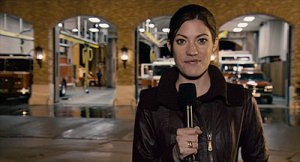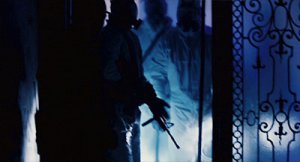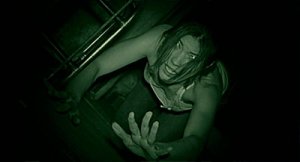Quarantine
Saturday, October 10th, 2009 • Horrorthon Posts / Horrorthon Reviews
At what point does a trend in the arts become a full-fledged sub-genre or even a “movement”? Manifestos can be written (the Bauhaus; Dada; Dogma) or critics can invent names for what they see (like Clement Greenberg coining “Abstract Expressionism” in the ‘Fifties). I’m not sure whether I’m looking at a trend, or a sub-genre, or a dogmatic movement, or what you’d call it, but I absolutely love what I see; after four (or five) excellent examples, the “found footage” movie is emerging as one of the most exciting, promising and effective techniques I’ve ever encountered. It’s especially interesting to me that the technique in question is so profound (involving a fundamental rethinking of the basic apparatus of movies themselves) and is connected so firmly to horror movies. It almost suggests that horror is intrinsically more “filmic” than any other type of story, which is an idea I like very much.
The “found footage”/”pseudo-documentary” format began in earnest ten years ago with The Blair Witch Project (1999) and continued with Cloverfield (2008). When no less impressive a figure than George A. Romero (himself the sole creator, arguably, of a horror movie sub-genre) decided to try it (Diary of the Dead in 2007) I realized that this was no fluke, but a genuine aesthetic form being born; the cinematic equivalent of the epistolary novel. Having just watched Quarantine (2008), I’m convinced that this technique is one of the best things to happen to movies, and horror, in decades.
[NOTE: As has been discussed elsewhere on Horrorthon, Quarantine is a remake of [Rec] (2007), a Spanish movie I have not seen, which apparently is an even better example of the “found footage” form. Obviously I can’t make comparisons until I’ve seen both of them, but I get the sense that the remake is unusually faithful and is respected by fans of the original. I watched this one first because I wanted to; sue me. I’ll see the other one later.]
I love “found footage” movies, because I think they’re a groundbreaking innovation (see below), but I especially love them because they’re all horror movies (they have to be). Stuff like Bob Roberts (1994) and This is Spinal Tap (1984) is totally different because those movies are made to resemble completed documentaries with editing, titles, music etc. It takes a horror-movie situation to generate a “found footage” movie because that’s the only reason to be watching raw footage: something interrupted the attempted journalism; something went terribly wrong, and the cameras were found later. (This is consistent across all the movies I’ve mentioned). The unaccompanied assembly of ersatz film or video is the essence of these movies (or, the first “rule” you’d list in the manifesto, if you wrote a “dogma”-style manifesto). Next is the fact that the footage is unadorned; there’s never any music, crossfades, superimposed titles, or anything beyond the “retrieved” sound and image. The third rule is that there must be one camera, and the camera must (of course) be part of the story; at every single moment there must be a legitimate reason for the filming or taping to be taking place. (The Blair Witch Project and Diary of the Dead break this rule, introducing more cameras, but Diary only does so in a tiny handful of scenes, and Blair Witch gets special dispensation.)
Making a horror movie with no music and only one camera (the presence of which must always be explained and justified) is a very demanding challenge, but I’m amazed at the heights of creative excellence that this challenge has already led to. I wrote above that “found-footage” movies are profound, and I mean that the technique re-arranges and re-invents the whole concept of movie storytelling so completely that its effects run far deeper than merely allowing new kinds of scares; it’s (dare I say) a whole new way to conceptualize how movies work; how scenes flow together, how events are presented and how meaning is conveyed to the audience. The “found-footage” technique is not without its detractors, who generally mount the same two objections: 1) you get nauseous (because of the endless bobbing and weaving of the handheld camera and 2) the ending is always unsatisfying (which is a charge leveled against all four of the movies I’ve mentioned; I don’t think that’s a coincidence). I can’t speak to the nausea; it is what it is. But the “ending” argument is more interesting, and I simply feel that audiences must (and soon will) get used to a different set of conventions about how stories end, as always happens whenever there’s a formal shift like this.
With Quarantine, it’s clear that the form is coming of age. Only certain stories lend themselves to this technique (all horror stories, as I wrote above) and the events in Quarantine fit the bill perfectly: an isolated time and place (the interior of a Los Angeles apartment building over approximately five hours); a legitimate reason for the camera to be there (a local television news reporter shooting a human-interest feature about the local fire station) and an in-your-face fatalism about the outcome (nobody survives a “found-footage” movie; that’s why we’re watching their found footage). Quarantine is spellbinding for all of these reasons. The music-free ambient soundtrack is a symphony of muffled and distorted slams and thumps, echoing footprints, distant sirens and helicopters; a dense tapestry of urban noise that serves the story with a nuance and subtlety that beats anything you could do with music. The performances (especially by Jennifer Carpenter, Hostel’s Jay Hernandez and Ally McBeal’s Greg Germann) are excellent examples of the kind of demanding hyper-naturalism that this sort of movie requires. (Carpenter has several great moments reminiscent of Heather Donahue’s famous confessionals in The Blair Witch Project.) The visuals are extremely good; the constant tricks with the camera just missing what we’re supposed to see, and the constant blurs and video cutoffs and static that interrupt the image, create a raw, beautiful flow of painterly grit and noise that enhances the story tremendously.
There’s business with a planted microphone that was so clever and exciting I was chuckling to myself, but on the whole I was frightened the entire time. That’s the great thing about “found-footage” movies (I’m already sick of this name; I’d welcome a better one): they’re scary as hell! I remember coming out of Cloverfield feeling like my mind was blown; I was looking around at the intact, sunlit New York as if I’d just come down from an acid trip. Blair Witch gave me nightmares that had me awakening in a cold sweat. Quarantine is no exception; I had the lights out while I watched and had that great “horror movie” chill down my spine the whole time. I really think “found-footage” is a genuinely new approach to storytelling, impossible in any other medium, and bursting with potential both for beautiful sound and image and for profound examinations of reportage, narrative self-awareness, and the glorious dance of systems breaking down, of order giving way to chaos. If you have any doubts about how awesome these “found footage” movies are, Quarantine will make you a believer.


